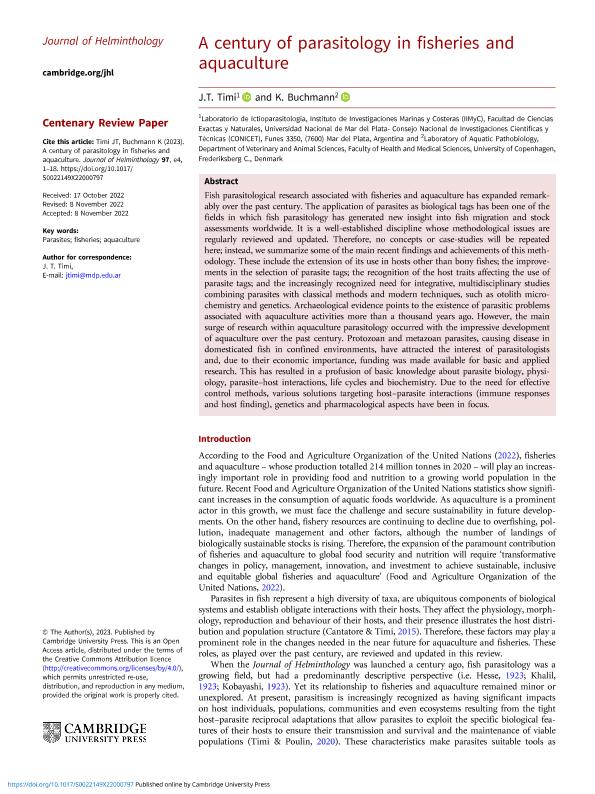Mostrar el registro sencillo del ítem
dc.contributor.author
Timi, Juan Tomas

dc.contributor.author
Buchmann, Kurt
dc.date.available
2023-10-26T19:55:55Z
dc.date.issued
2023-02
dc.identifier.citation
Timi, Juan Tomas; Buchmann, Kurt; A century of parasitology in fisheries and aquaculture; Cambridge University Press; J. Helminthol.; 97; 2-2023; 1-18
dc.identifier.issn
0022-149X
dc.identifier.uri
http://hdl.handle.net/11336/216123
dc.description.abstract
Fish parasitological research associated with fisheries and aquaculture has expanded remarkably over the past century. The application of parasites as biological tags has been one of the fields in which fish parasitology has generated new insight into fish migration and stock assessments worldwide. It is a well-established discipline whose methodological issues are regularly reviewed and updated. Therefore, no concepts or case-studies will be repeated here; instead, we summarize some of the main recent findings and achievements of this methodology. These include the extension of its use in hosts other than bony fishes; the improvements in the selection of parasite tags; the recognition of the host traits affecting the use of parasite tags; and the increasingly recognized need for integrative, multidisciplinary studies combining parasites with classical methods and modern techniques, such as otolith microchemistry and genetics. Archaeological evidence points to the existence of parasitic problems associated with aquaculture activities more than a thousand years ago. However, the main surge of research within aquaculture parasitology occurred with the impressive development of aquaculture over the past century. Protozoan and metazoan parasites, causing disease in domesticated fish in confined environments, have attracted the interest of parasitologists and, due to their economic importance, funding was made available for basic and applied research. This has resulted in a profusion of basic knowledge about parasite biology, physiology, parasite-host interactions, life cycles and biochemistry. Due to the need for effective control methods, various solutions targeting host-parasite interactions (immune responses and host finding), genetics and pharmacological aspects have been in focus.
dc.format
application/pdf
dc.language.iso
eng
dc.publisher
Cambridge University Press

dc.rights
info:eu-repo/semantics/openAccess
dc.rights.uri
https://creativecommons.org/licenses/by/2.5/ar/
dc.subject
AQUACULTURE
dc.subject
FISHERIES
dc.subject
PARASITES
dc.subject.classification
Ecología

dc.subject.classification
Ciencias Biológicas

dc.subject.classification
CIENCIAS NATURALES Y EXACTAS

dc.title
A century of parasitology in fisheries and aquaculture
dc.type
info:eu-repo/semantics/article
dc.type
info:ar-repo/semantics/artículo
dc.type
info:eu-repo/semantics/publishedVersion
dc.date.updated
2023-10-12T14:47:10Z
dc.journal.volume
97
dc.journal.pagination
1-18
dc.journal.pais
Reino Unido

dc.journal.ciudad
Cambridge
dc.description.fil
Fil: Timi, Juan Tomas. Consejo Nacional de Investigaciones Científicas y Técnicas. Centro Científico Tecnológico Conicet - Mar del Plata. Instituto de Investigaciones Marinas y Costeras. Universidad Nacional de Mar del Plata. Facultad de Ciencias Exactas y Naturales. Instituto de Investigaciones Marinas y Costeras; Argentina
dc.description.fil
Fil: Buchmann, Kurt. University Of Copenhagen. Faculty Of Health And Medical Sciences.; Dinamarca
dc.journal.title
J. Helminthol.

dc.relation.alternativeid
info:eu-repo/semantics/altIdentifier/url/https://www.cambridge.org/core/journals/journal-of-helminthology/article/century-of-parasitology-in-fisheries-and-aquaculture/26C679CFDBEE931B477EC2FA0631ECE3
dc.relation.alternativeid
info:eu-repo/semantics/altIdentifier/doi/https://doi.org/10.1017/S0022149X22000797
Archivos asociados
